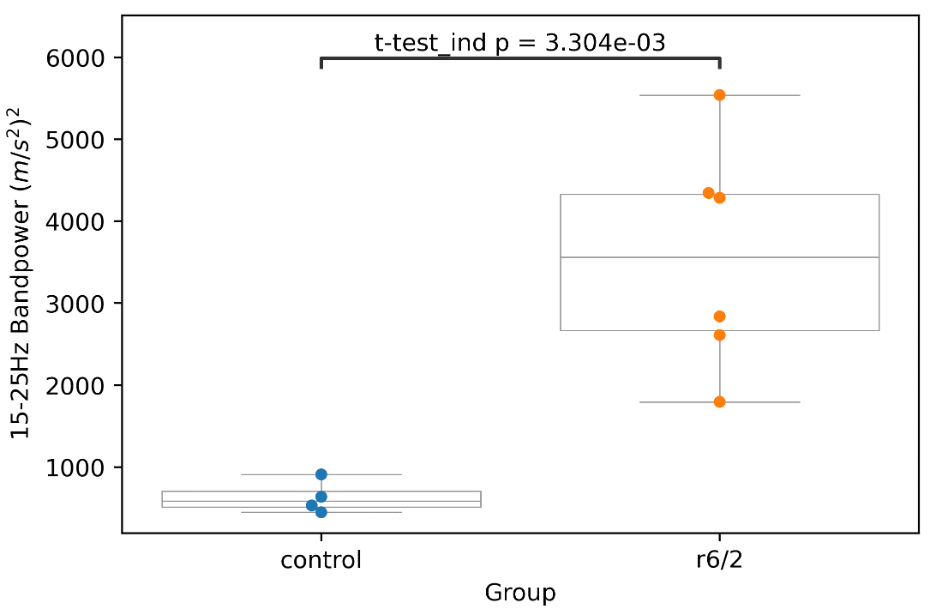Category: Huntington's Disease
Objective: To better characterize and precisely quantify the tremor widely observed in R6/2 mouse models of Huntington’s disease.
Background: Tremor is a prominent feature of the R6/2 mouse model of Huntington’s disease, becoming apparent in all animals as they progress in age. This has been previously described as both an indicator of disease onset and a treatment outcome, though only with subjective, binary visual assessment [1,2]. However, it has the potential to be used as an objective and precisely quantifiable biomarker in this widely used model. Accelerometric measurement of tremor in HD model mice could be used to compare disease severity, and its temporal progression, between treatment groups. It could also be used to reliably distinguish acute and chronic effects of treatment.
Method: A pilot group (n=6) of 14 week old R6/2 mice were compared against a group (n=4) of age matched C57Bl6J controls. These mice were part of a gene therapy trial, and had a mixture of different transgenes virally expressed in their striatum, none of which had an apparent impact on behavior or the HD model disease course. Tremor was assessed by placing individual mice in a suspended enclosure from which accelerometric data was recorded for 5 minutes at a sampling rate of 100Hz. The 15-20Hz bandpower was calculated from the acceleration data for each recording, with the mean bandpower compared between the R6/2 and control groups.
Results: The R6/2 group had a significantly higher mean 15-25Hz bandpower (p=.003304, unpaired t-test) in their accelerometric recordings. Additionally all R6/2 mice had visible tremor that was not present in the control animals.
Conclusion: Tremor was readily quantifiable in R6/2 mice using widely available tools, late in their disease course progression. Ongoing work will attempt to characterize the development of tremor along that disease course, as well as to better characterize the tremor according to spectral content and its association with behavior.
References: [1] Jin K, LaFevre-Bernt M, Sun Y, et al. FGF-2 promotes neurogenesis and neuroprotection and prolongs survival in a transgenic mouse model of Huntington’s disease. Proc Natl Acad Sci U S A. 2005;102(50):18189-18194. doi:10.1073/pnas.0506375102 [2] Mangiarini L, Sathasivam K, Seller M, et al. Exon 1 of the HD gene with an expanded CAG repeat is sufficient to cause a progressive neurological phenotype in transgenic mice. Cell. 1996;87(3):493-506. doi:10.1016/s0092-8674(00)81369-0
To cite this abstract in AMA style:
H. Skelton, D. Grogan, J. Rubiano, R. Gross, C. Gutekunst. Quantifying Tremor in the R6/2 Mouse model of Huntington’s Diease [abstract]. Mov Disord. 2021; 36 (suppl 1). https://www.mdsabstracts.org/abstract/quantifying-tremor-in-the-r6-2-mouse-model-of-huntingtons-diease/. Accessed December 18, 2025.« Back to MDS Virtual Congress 2021
MDS Abstracts - https://www.mdsabstracts.org/abstract/quantifying-tremor-in-the-r6-2-mouse-model-of-huntingtons-diease/

